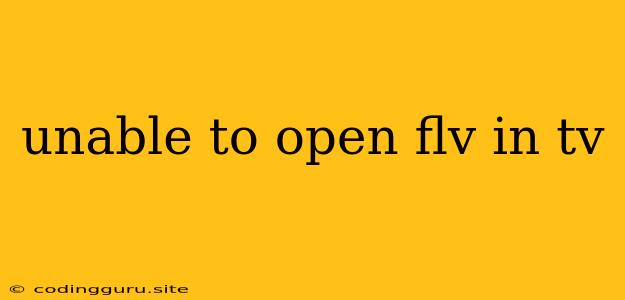Why Can't I Open FLV Files on My TV?
Have you ever tried to play a FLV file on your TV, only to be met with an error message or a blank screen? You're not alone! FLV files, a popular video format used for streaming online content, can be tricky to play on TVs, especially older models. But don't worry, we're here to help you figure out why you're facing this problem and how to fix it!
Understanding the Problem
The issue lies in the fact that TVs often don't have built-in support for FLV files. Most modern TVs support common formats like MP4, AVI, and MKV, but FLV might not be included in the list.
Possible Reasons for the Issue
Here are some common reasons why you might be unable to open FLV files on your TV:
- Your TV doesn't support FLV playback. Many older TVs or smart TVs with basic functionality may not support this format.
- The FLV file is corrupted or damaged. This can happen during download or transfer.
- You're trying to play the FLV file from an unsupported source. Some media players or apps on your TV might not handle FLV files.
Solutions to Open FLV Files on Your TV
Let's tackle these challenges with some possible solutions:
1. Convert FLV to a Supported Format:
- This is the most reliable solution. Use a video converter software like Handbrake or VLC Media Player to convert your FLV file to a format compatible with your TV, such as MP4 or AVI.
- Once converted, simply transfer the new file to your TV using a USB drive, network sharing, or streaming services.
2. Use a Media Player that Supports FLV:
- If your TV has a built-in media player, check if it supports FLV playback. You can often find this information in the user manual or online.
- Alternatively, consider using a dedicated media player app from your TV's app store that supports FLV playback.
3. Utilize a Streaming Device:
- Devices like Amazon Fire TV Stick, Chromecast, or Roku can handle FLV files. Connect your streaming device to your TV and then use a compatible app like VLC for Android or Kodi to play the FLV file.
4. Check File Integrity:
- If you suspect the FLV file is corrupted, try downloading it again from the original source.
- If the issue persists, try using a different browser or device to download the file.
5. Update TV Firmware:
- Sometimes, updating your TV's firmware can add support for new file formats. Check the TV's manufacturer website for the latest firmware updates.
Example: Using VLC Media Player to Convert FLV
- Download and install VLC Media Player: It's available for free on Windows, macOS, and Linux.
- Open VLC and click on "Media" > "Convert / Save."
- Click on "Add" to select your FLV file.
- Click on the "Convert / Save" button.
- Choose a compatible format (like MP4) and select a destination folder.
- Click on "Start" to begin the conversion.
Once the conversion is complete, you can transfer the new MP4 file to your TV and play it.
Tips for Preventing FLV Playback Issues
- Check the file format before downloading: Ensure the video file you're downloading is in a compatible format for your TV.
- Download from reliable sources: Ensure you're downloading from trusted websites to minimize the risk of corrupted files.
- Keep your TV firmware updated: Regularly update your TV's firmware for the latest features and compatibility.
Conclusion
While FLV might not be as universally supported as other video formats, it's not impossible to open them on your TV. By following the tips and solutions above, you should be able to enjoy your favorite FLV content on the big screen without any further frustration. Remember to check for support before downloading, and always opt for reliable sources.
